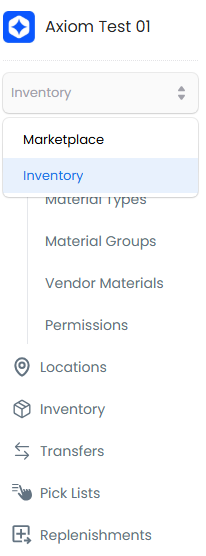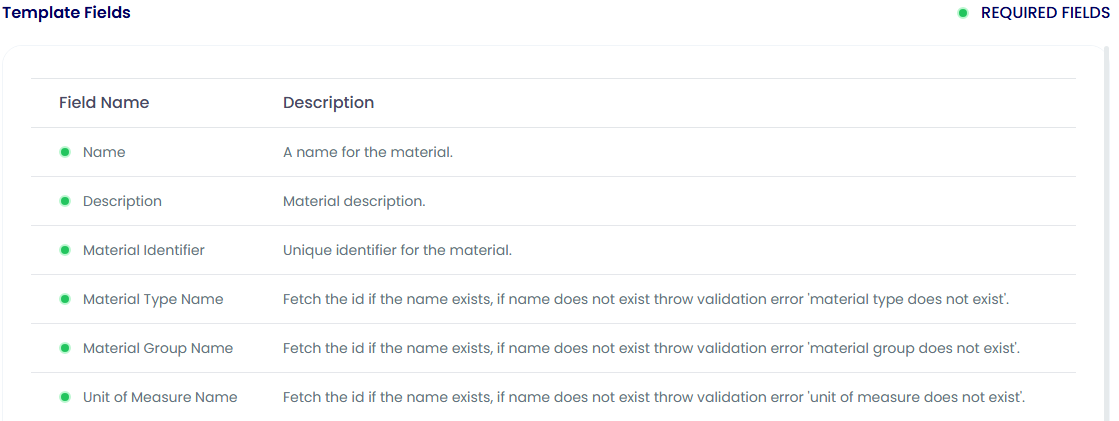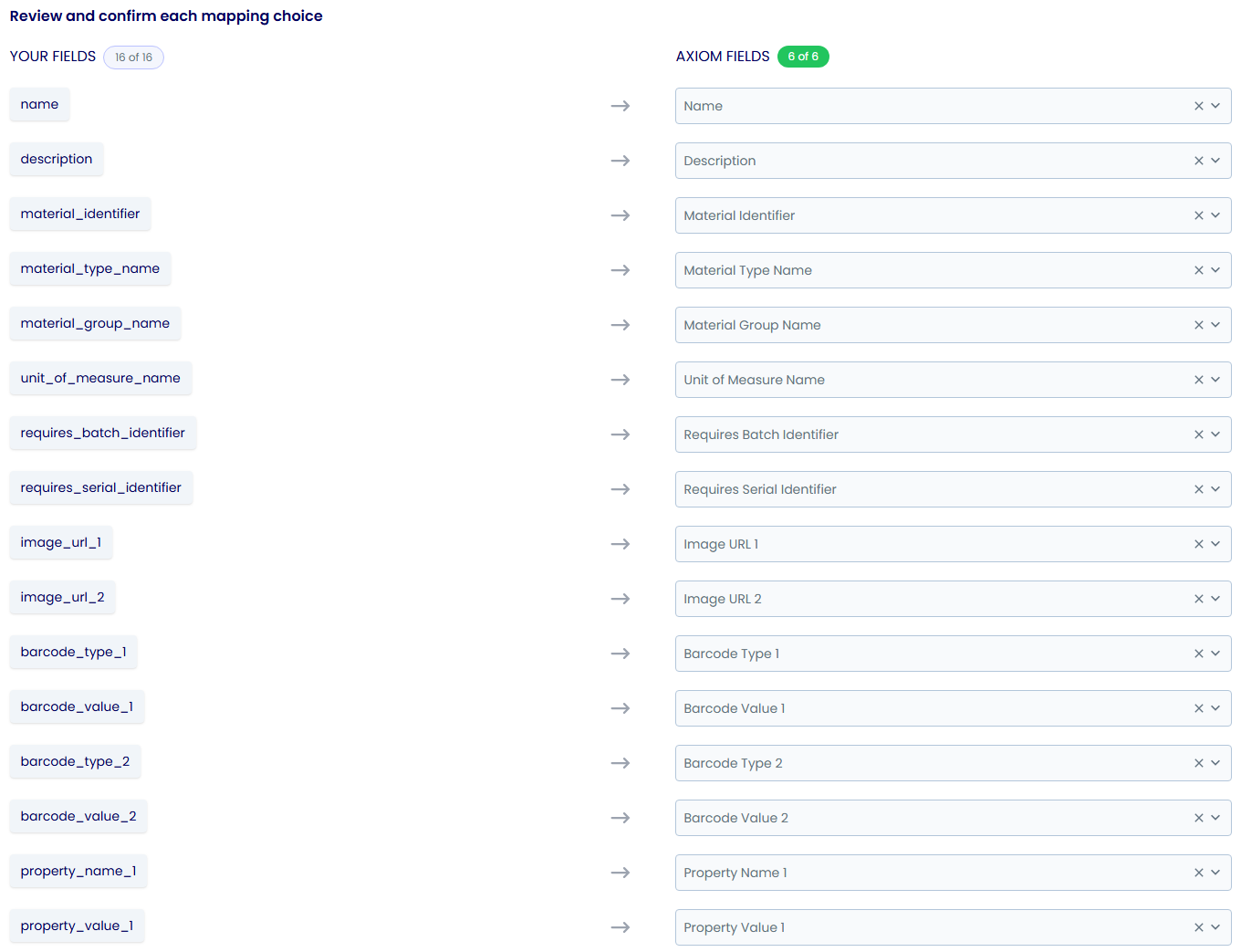Material Imports
Learn how to efficiently manage your materials catalog through bulk imports and updates using CSV files.
Overview
The Material Import feature provides a powerful way to manage large numbers of materials efficiently. This tool helps you:
- Add or update hundreds of materials at once
- Maintain data consistency across your catalog
- Save time compared to manual entry
- Process changes in the background
- Track and verify all updates
Key Features
- Bulk Operations: Handle multiple materials in a single operation
- Background Processing: Continue working while imports run
- Progress Tracking: Monitor import status and results
- Data Validation: Ensure data accuracy before import
- Flexible Updates: Create new or update existing materials
Benefits
Time Efficiency
- Reduce manual data entry
- Process large catalogs quickly
- Update multiple fields at once
- Automate repetitive tasks
- Handle bulk changes efficiently
Data Quality
- Consistent data formats
- Validated information
- Complete material records
- Accurate relationships
- Traceable updates
Prerequisites
Before starting an import, ensure you have:
- Valid Material Groups in your store
- Valid Units of Measure (UOM) in your store
- Your material data prepared in CSV format
TIP
The import will fail if referenced Material Groups or UOMs don't exist in your store.
Importing Materials
To import materials:
- Select
Inventoryfrom the landing page dropdown

- Click
Importon the Materials landing page

- Download and fill out the template

- Upload your completed CSV file

- Map your fields and click
Continue

- Review your data and click
Submit

CSV Template Fields
Required Fields
| Field | Description |
|---|---|
| name | Descriptive name that clearly identifies the material |
| material_identifier | Unique identifier used for updates - must be consistent across systems |
| material_group_name | Valid group name from your store - organizes materials logically |
| unit_of_measure_name | Valid UOM from your store - ensures consistent quantity measurements |
Optional Fields
| Field | Description |
|---|---|
| description | Detailed description of material characteristics and usage |
| material_type_name | Must match existing type - defines material properties and validation |
| requires_batch_identifier | Set to "true" for batch-tracked materials, "false" otherwise |
| requires_serial_identifier | Set to "true" for serialized materials, "false" otherwise |
| image_url_1 to image_url_5 | Valid URLs for material images - helps with visual identification |
| barcode_type_1/value_1 to type_5/value_5 | Pairs of barcode type and value for material tracking |
| property_name_1/value_1 to name_5/value_5 | Custom property pairs for additional material attributes |
| common_part_number_1 to number_5 | Alternative part numbers for cross-referencing |
Field Guidelines
Material Names
- Use clear, descriptive names
- Follow consistent naming conventions
- Include relevant specifications
- Avoid abbreviations unless standard
- Keep names concise but meaningful
Identifiers
- Use consistent identifier formats
- Ensure uniqueness across systems
- Include relevant prefixes if needed
- Document identifier structure
- Maintain identifier history
Groups and Types
- Verify group existence before import
- Use correct group names exactly
- Match type names precisely
- Consider group hierarchies
- Plan for future categorization
Custom Properties
- Use standardized property names
- Provide complete property pairs
- Follow value format requirements
- Document property purposes
- Consider reporting needs
TIP
For barcode types, use standard formats like QR Code, PDF417, Data Matrix, Code 39, Code 128, GS1-128, EAN-8/13, UPC-A/E.
Import Process
During import:
- Each row is validated for required fields and data format
- System checks material_identifier:
- New identifiers create materials
- Existing identifiers update materials
- Images, barcodes, and properties are applied
- Results are available in the import history
Update Behavior
When updating existing materials:
- Barcodes are completely replaced with new values
- Image URLs are refreshed from the CSV
- Properties are replaced with new values
- Material type changes may be blocked if required fields exist
Troubleshooting
Common errors and solutions:
- "Material group does not exist": Create the group first
- "Unit of measure does not exist": Add the UOM first
- "Material type does not exist": Fix the type name or leave blank
- Invalid barcode type: Use standard format
- Boolean fields: Use exactly "true" or "false"
- Image URLs: Must be valid web links
Best Practices
Preparation
- Back up your data before large imports
- Test with a small sample first
- Verify all referenced data exists
- Clean and validate your CSV data
- Document your import process
CSV File Management
- Use the provided template
- Keep consistent column order
- Validate data formats
- Remove duplicate entries
- Save backups of import files
Import Process
- Start with small batches
- Monitor import progress
- Review error messages carefully
- Document any issues encountered
- Keep import logs for reference
Data Validation
- Check required field values
- Verify field relationships
- Validate data formats
- Review special characters
- Test complex field values
Post-Import
- Verify imported records
- Check relationships
- Test material functionality
- Document any issues
- Update related records
TIP
When updating existing materials, consider exporting the current data first. This provides a backup and helps you understand the existing data structure.
- Overview
- Key Features
- Benefits
- Time Efficiency
- Data Quality
- Prerequisites
- Importing Materials
- CSV Template Fields
- Required Fields
- Optional Fields
- Field Guidelines
- Material Names
- Identifiers
- Groups and Types
- Custom Properties
- Import Process
- Update Behavior
- Troubleshooting
- Best Practices
- Preparation
- CSV File Management
- Import Process
- Data Validation
- Post-Import